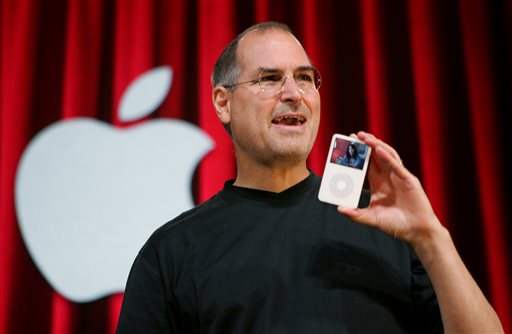Jobs began pushing for a portable music player in the fall of 2000,
2000年秋天,乔布斯开始督促设计便携式音乐播放器,
but Rubinstein responded that the necessary components were not available yet. He asked Jobs to wait.
但是鲁宾斯坦回应说还缺少一些重要的部件,他让乔布斯再等一阵子。
After a few months Rubinstein was able to score a suitable small LCD screen and rechargeable lithium-polymer battery.
几个月之后,鲁宾斯坦开始选择合适的液晶屏幕和可充电的锂电池。
The tougher challenge was finding a disk drive that was small enough but had ample memory to make a great music player.
不过,最大的挑战在于要找到一个尺寸小但存储空间大的硬盘。
Then, in February 2001, he took one of his regular trips to Japan to visit Apple's suppliers.
之后,2001年2月,他去了日本的苹果供应商那里作例行访向。
At the end of a routine meeting with Toshiba,
在和东芝公司开完例会之后,
the engineers mentioned a new product they had in the lab that would be ready by that June.
工程师们提到,他们正在实验室研发一项新产品,到6月可以完成。

It was a tiny, 1.8-inch drive (the size of a silver dollar)
那是一个1.8英寸见方的硬盘(大约是1美元硬币的大小),
that would hold five gigabytes of storage (about a thousand songs), and they were not sure what to do with it.
带有5G的内存(大约能存放1000首歌曲),但他们不知道可以用它来做什么。
When the Toshiba engineers showed it to Rubinstein, he knew immediately what it could be used for.
当东芝的工程师把这个小硬盘展示给鲁宾斯坦时,他立刻就想到了该怎么利用它。
A thousand songs in his pocket! Perfect. But he kept a poker face.
把1000首歌装进口袋!这主意太棒了!但他当时不动声色。
Jobs was also in Japan, giving the keynote speech at the Tokyo Macworld conference.
乔布斯当时也在日本,他正在东京的Macworld大会上作主旨演讲。
They met that night at the Hotel Okura, where Jobs was staying.
他们当晚就在乔布斯下榻的大仓酒店见面。
"I know how to do it now," Rubinstein told him. "All I need is a $10 million check."
鲁宾斯坦告诉他:“我知道现在该怎么做了,我只需要一张1000万美元的支票。”
Jobs immediately authorized it.
乔布斯马上就批准了。
So Rubinstein started negotiating with Toshiba to have exclusive rights to every one of the disks it could make,
后来鲁宾斯坦开始和东芝谈判,希望买下所有小硬盘的专有权,
and he began to look around for someone who could lead the development team.
然后,他便开始物色可以领导开发团队的人选。



